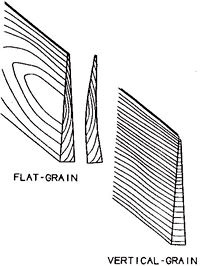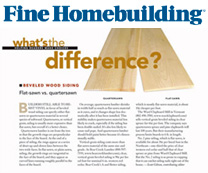About Vertical Grain Clapboards
WARD CLAPBOARDS are produced by a unique radial sawing process, equivalent to rift sawing (except producing tapered boards as opposed to rectangular boards)
Rift sawn wood is the most expensive and least common. Milling perpendicular to the log’s growth rings producing a linear grain pattern with no flecking. Rift sawn lumber is very dimensionally stable and has a unique linear appearance. Rift sawn lumber is superior to quatersawn lumber, and far superior to flatsawn lumber
Radial sawing was employed in the 19th century to produce durable vertical grain clapboards. Ward Clapboard Mill manufactures only radially sawn vertical grain clapboards, the same way we have made them since the 1800's. Unlike flat grain clapboards manufactured by many mills today, Ward Clapboard Mill's Vertical Grain Clapboards:
- cup and twist less
- shrink and swell less
- are especially suited to certain application, particularly siding
- wear extremely well (some 100 year-old New England homes are still protected from the weather by their original vertical grain clapboards)
- have a square edge, producing a sharp shadow line and a superb drip edge
- accept paint and stain extremely well, producing an even-toned, exceptionally long-lasting finish
- may be left unfinished, resulting in an exceptionally beautiful weathered silver-gray appearance
At Ward Clapboard Mill we use both white pine and red spruce to manufacture our vertical-grain Beveled Siding. We first prepare the logs for sawing by debarking and rounding them on a lathe. Logs are then placed in a carriage and passed over a saw. Depending on the diameter of the log, cuts are made from 4½" to 6½" deep the full length of the log. Each time the log returns for the next cut, it is rotated 5/8" until it has rotated a full 360°. This gives the clapboards its taper and true vertical grain. Our clapboards are manufactured in lengths no longer than 6'. This makes our clapboards easy to handle for one-person installation, and reduces cupping & twisting even more. Cutting a clapboard in this way also allows us to make the most economical cut possible from the logs, producing a premium product at an affordable price.

